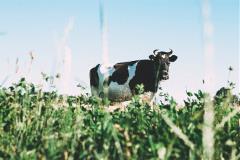Dairy Cattle Udder Hygiene to Prevent Milk Contamination

When milking a dairy cow with an udder that is clean and free of infection, the milk is sterile until the moment it is secreted. In order to retain the milk's healthy condition, it is absolutely essential to take the proper steps that will help to avoid bacterial contamination.
Contaminated milk can become a breeding ground for bacteria, yeast, and mold. When polluted, milk quality quickly deteriorates. As its condition decreases, the chance for using the milk for either liquid consumption or for being manufactured into dairy products diminishes.
When running a dairy operation, the following tips will help to put milk in the tank that is clean and free from contaminants.
Avoiding Bacterial Contamination in Milk - Focus on Cleanliness
Tip #1. Udder and teats
Keeping udders free of infection requires steps to fight against mastitis. While it is difficult to have a herd that is 100% mastitis free, steps can be adopted that will help to reduce the number of cows affected.
Pre-milking practices should include the following steps of routine udder preparation procedures:
- Use a clean paper towel or washing cloth for each cow:
- Thoroughly wash udders using clean water with an added disinfectant, such as sodium hypochlorite
- If water becomes dirty, empty the container and fill with new
- Once udder is washed and clean, dry udder to avoid contaminated water from leaking into teat cups
- Used paper towels should be thrown away
- When a wash cloth is used, they should be disinfected and dried before being used again in the next round of milking
- When cows are housed on lots or in pastures with multiple animals, their environment can become very dirty which increases the chance for the surface of the udder to become easily contaminated with bacteria
- When cows are visibly dirty, the grime on their udders and teats must be removed
- If the dirt is muddy or is heavily caked on the udder, gently spraying the udder with water may help to loosen and remove it
- Muddy or caked dirt may also be removed with a careful and gentle brushing
- Once the visible dirt is removed, the routine procedures for udder preparation before milking should then be followed
- If the floor of the milking stations becomes overly dirty or muddy, clear the area of dirt before bringing in and milking a new cow.
Tip #2. Pre-milking Sanitization
Used to decrease the risk of a transfer of contamination between teat ends and milking machines, a pre-dip teat sanitizer applied after udder is washed and dried, but prior to the attachment of the teat cups, can help to remove the chance for milk contamination caused by environmental bacteria such as:
- Streptococcus uberis
- Escherichia coli
- Klebsiella pneumoniae
The suggested steps for using the pre-dip sanitizer include:
- Clean teats
- Forestrip milk
- Application of the pre-dip sanitizer or spray
- Allow for contact time, according to product
- Dry teat thoroughly to remove excess germicidal product, microorganisms, organic material
- Attach teat cups
Tip #3. Post-milking Teat Dip
One of the most effective management tools used to prevent mastitis is the application of a post-milking antiseptic. Found to significantly reduce the rate of new bacteria-causing intra-mammary infections, the germicidal solutions used in teat dips and sprays work to clean, disinfect, and seal the teat opening, which helps to fight against the start of infections most commonly caused by:
- Staphylococcus aureus
- Streptococcus agalactiae
- Mycoplasma bovis
- Corynebacterium bovis
It is noted that while spraying is faster, dipping the teat is a more thorough means of covering the teat surface. Some feel the dip cup increases the possibility of spreading bacteria from cow to cow. However, the germicides help to keep the dip from being contaminated with bacteria. The most important point is to cover the entire teat surface.
To avoid contamination that may lower the quality of the milk, cleanliness is key!
For additional information on maintaining dairy herd health, contact your Covetrus representative at 855.724.3461.
Sources:http://www.nmconline.org/articles/teatdip.htm
http://www.fao.org/docrep/004/T0218E/T0218E03.htm#ch3.1Need Regulatory Assistance
If you need help with regulatory or licensing issues, we're happy to help. We have a wide variety of resources to help you when issues arise.

Careers
Are you looking for a place to let your talents shine? At Covetrus, we help our practitioner customers better serve their patients and take pride in providing the best customer experience possible. Search our open positions to see our available opportunities.
Newsletter
Stay current with what’s going on with Covetrus, subscribe to receive our newsletter and email communications. Subscribers will receive the latest information in practice management, sales and marketing, animal health, and more.


Leave a comment